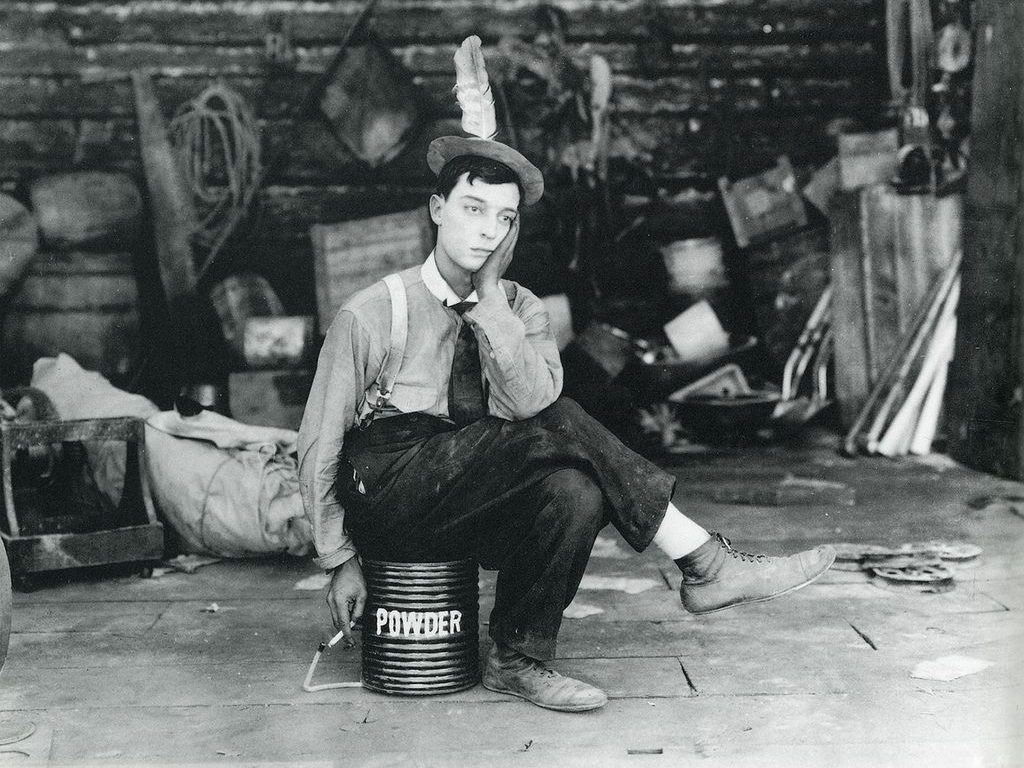THE SCARECROW
Buster Keaton, Eddie Cline (US 1920)
In March 1917 Buster Keaton called into Roscoe Arbuckle’s film studio out of pure curiosity, and remained there for almost three years. Throwing up an auspicious vaudeville career, he took a salary of $40 dollars a week to work in pictures, learn the craft, and in time to become Arbuckle’s creative partner in the production of a triumphant series of comedy shorts.
In 1920, however, Arbuckle moved on to act in features for Paramount. Their producer Joseph M. Schenck thereupon set up a new company and established Keaton in his own studio – formerly Chaplin’s Lone Star Studio, where his supreme series of Mutual productions had been made. Keaton’s first production, The High Sign, disappointed him, and he shelved it for half a year. After an interruption to fulfil a contract to act in a Metro feature, The Saphead, he returned to make in succession the enduring masterpiece One Week, and one of his darkest and most violent comedies, Convict 99.
The Scarecrow, which followed, was something of a throw-back to earlier Arbuckle two-reelers, in that it divides into two nearly independent episodes. The first introduces one of Keaton’s earliest mechanized houses, which Buster shares with big Joe Roberts, and which has fun with Fordian automation and current space-saving post-war housing. “All the rooms in this house are in one room”: the gramophone is convertible into a gas stove; a series of pulleys and strings produces comestibles from the icebox and condiments from the ceiling; a little train runs up and down the table conveying rolls and butter. After the meal, all the eating equipment hides away, and the table-top is hung on a wall to reveal a text (“What is home without a mother”) on the verso. The bath is turned on its side and becomes a sofa as the water empties through a trap into the duck pond. The bed tips up and converts to an organ.
In the second half, Buster and Joe leave their house for the village, where they battle fiercely over their rivalry for the farmer’s daughter, and Buster flees a dog (a guest appearance by Arbuckle’s pet bull terrier Luke) who is foaming at the mouth after stealing a cream pie. Having been stripped of his clothes in a harvester, Buster is obliged to steal the clothes and take the place of the scarecrow of the title. The final trajectory, by horse, motorcycle, and water, is fast and faultless. Surviving prints of the film may lack a scene which would have explained Big Joe’s nefarious purpose in buying crutches and surgical supplies (which nevertheless come in handy when he is hit by a truck).
David Robinson
The music The 1920 short The Scarecrow, directed by Buster Keaton and Eddie Cline, is set to music by the orchestra and choir of the P. P. Pasolini secondary school, with original swing and blues pieces that recall the period in which the film was made, plus transcriptions from classical compositions by Tchaikovsky and Shostakovich. Following a suffused introduction with strings and woodwind, the film begins in the one-room house shared by two friends who are rivals in love. The breakfast scene, the funniest in the film, is characterized by a reassuring 19th-century waltz.
The acrobatic virtuosity of a violin accompanies the chase of the dog who, after various adventures, eventually makes friends with Buster. In the final sequence the clever farmhand manages to elope with his sweetheart after a hilarious escape. The scene is accompanied by a vocal-instrumental canon, in blues style, with electric guitar and drums. A crescendo culminates in the whirlwind wedding of the two lovers.
The original music and transcriptions were composed by conductor Patrizia Avon; the choir is led by Laura Martin.
Patricia Avon

regia/dir, scen: Buster Keaton, Eddie Cline.
photog: Elgin Lessley.
tech. dir: Fred Gabourie.
cast: Buster Keaton (bracciante/farm hand), Sybil Seely (la figlia del fattore/farmer’s daughter), Joe Roberts (bracciante/farm hand), Eddie Cline (camionista/truck driver?), Joe Keaton (fattore/farmer), Luke the Dog.
prod: Joseph M. Schenck, Comique Film Corporation, Inc.
dist: Metro Pictures.
copia/copy: DCP, 18′; did./titles: ENG.
fonte/source: Lobster Films, Paris.


 Italiano
Italiano